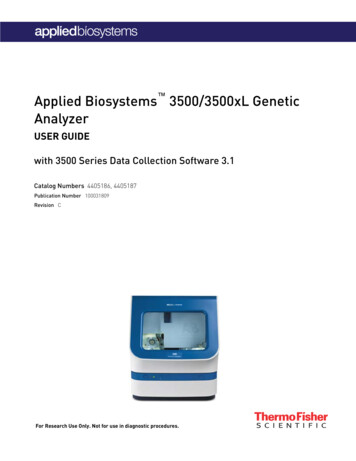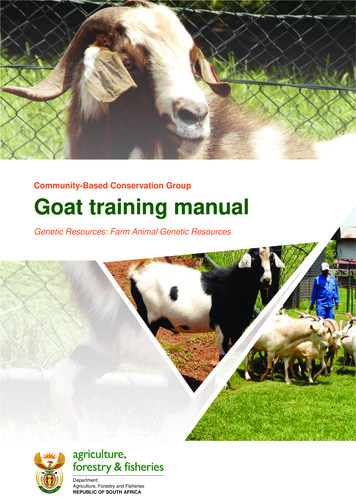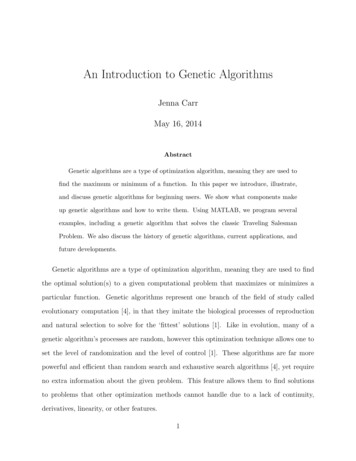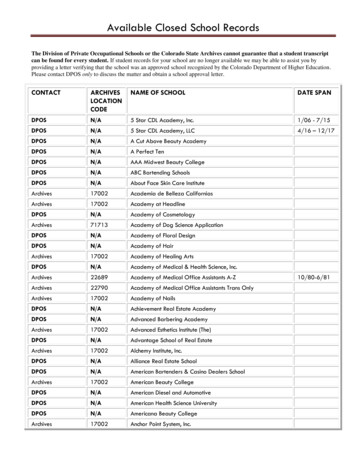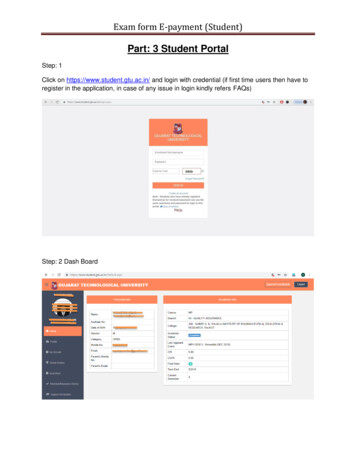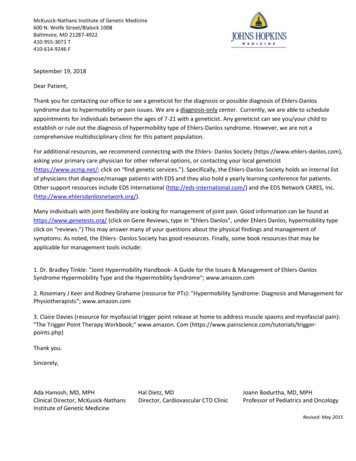
Transcription
McKusick-Nathans Institute of Genetic Medicine600 N. Wolfe Street/Blalock 1008Baltimore, MD 21287-4922410-955-3071 T410-614-9246 FSeptember 19, 2018Dear Patient,Thank you for contacting our office to see a geneticist for the diagnosis or possible diagnosis of Ehlers-Danlossyndrome due to hypermobility or pain issues. We are a diagnosis-only center. Currently, we are able to scheduleappointments for individuals between the ages of 7-21 with a geneticist. Any geneticist can see you/your child toestablish or rule out the diagnosis of hypermobility type of Ehlers-Danlos syndrome. However, we are not acomprehensive multidisciplinary clinic for this patient population.For additional resources, we recommend connecting with the Ehlers- Danlos Society (https://www.ehlers-danlos.com),asking your primary care physician for other referral options, or contacting your local geneticist(https://www.acmg.net/; click on “find genetic services.”). Specifically, the Ehlers-Danlos Society holds an internal listof physicians that diagnose/manage patients with EDS and they also hold a yearly learning conference for patients.Other support resources include EDS International (http://eds-international.com/) and the EDS Network CARES, Inc.(http://www.ehlersdanlosnetwork.org/).Many individuals with joint flexibility are looking for management of joint pain. Good information can be found athttps://www.genetests.org/ (click on Gene Reviews, type in “Ehlers Danlos”, under Ehlers Danlos, hypermobility typeclick on “reviews.”) This may answer many of your questions about the physical findings and management ofsymptoms. As noted, the Ehlers- Danlos Society has good resources. Finally, some book resources that may beapplicable for management tools include:1. Dr. Bradley Tinkle: "Joint Hypermobility Handbook- A Guide for the Issues & Management of Ehlers-DanlosSyndrome Hypermobility Type and the Hypermobility Syndrome"; www.amazon.com2. Rosemary J Keer and Rodney Grahame (resource for PTs): "Hypermobility Syndrome: Diagnosis and Management forPhysiotherapists"; www.amazon.com3. Claire Davies (resource for myofascial trigger point release at home to address muscle spasms and myofascial pain):"The Trigger Point Therapy Workbook;" www.amazon. Com ts.php)Thank you.Sincerely,Ada Hamosh, MD, MPHClinical Director, McKusick-NathansInstitute of Genetic MedicineHal Dietz, MDDirector, Cardiovascular CTD ClinicJoann Bodurtha, MD, MPHProfessor of Pediatrics and OncologyRevised: May 2015
New Patient Appointment QuestionnaireInstitute of Genetic Medicine, Johns Hopkins UniversityEhlers Danlos syndrome/hypermobilityDear Patient/Parent,Thank you for your interest in having a clinic appointment in the Institute of Genetic Medicine at JohnsHopkins.IMPORTANT: If you are pregnant, OR, have an urgent vascular problemplease DO NOT complete this packet and call 410-955-0316 (Gretchen MacCarrick)In order for us to prepare for your appointment, we ask that you fill out the attached questionnaire. We areworking to have this become a confidential electronic process through MyChart. Once completed, pleasereturn the questionnaire back with any additional records by:Fax: 410-614-9246Phone: 410-955-3071Email: CTDinfo@jhmi.eduMail: Genetic Counselors--CTDInstitute of Genetic Medicine, Johns Hopkins University600 N. Wolfe St, Blalock 1008Baltimore, MD 21287Once we receive your questionnaire and any additional records, a genetic counselor will review yourinformation and determine the appropriate physician to see the patient and determine if there are anyneeded ancillary appointments to be scheduled before or on the day of the appointment. Appointments willbe scheduled in the order questionnaires are received. We will do our best to have the patient scheduled assoon as possible; however please be patient as we have a high volume of appointment requests. Weschedule about 4-6 months in advance, depending on urgency and diagnosis.Sincerely,Clinical Staff, Institute of Genetic MedicineRevised: May 2015
Institute of Genetic MedicineJohns Hopkins MedicineEhlers Danlos syndrome/hypermobilityThis questionnaire is to be completed if you or your child was referred due to hypermobility or the possibility ofEhlers Danlos syndrome, hypermobile type. If you/he/she was supposed to be referred a general clinic or anotherspecialty clinic, please contact our office at 410-955-3071 option 1 to be sent another questionnaire.Patient’s Name:Patient’s Date of birth: / /Phone:Name of referring doctor (indicate self-referral if no referring doctor):Doctor Name: Phone: Fax:Address:Reason(s) for appointment:1. Has the patient ever seen a genetics specialist before?Yes / No (circle one)If YES, please list the name and the location of this specialist(s) and attach evaluation notes:2. Does the patient have a confirmed genetic diagnosis of Ehlers Danlos syndrome? If there is a confirmed geneticdiagnosis, please attach genetic evaluation and/or testing reports. Please circle the appropriate choice:Confirmed diagnosis of (please attach genetic records): Classic or hypermobile Ehlers Danlos syndrome Vascular Ehlers Danlos syndrome Other:3. If the appointment request is to evaluate for a potential diagnosis, please circle the appropriate reason(s):Joint hypermobility/subluxation/dislocationAortic dilation/dissection—rule out syndrome (Marfan, Loeys Dietz or Vascular Ehlers Danlos)Family history ofOther:4. It is helpful for us to better understand the patient and his/her family’s MEDICAL PROBLEMS. Please check whichsymptoms the patient and anyone in their family have.Findings in FamilyPresent inpatientPresent inrelative (age)Specify relationAortic dilation/dissectionArterial aneurysmArterial tortuosity syndromeBicuspid aortic valveCarotid/coronary dissectionArrhythmias, pacemakersPOTSRevised: May 2015
Neurally mediated hypotensionCongenital heart defectsDislocated lensesRetinal detachmentMyopiaEhlers Danlos (type)Familial thoracic aneurysmLoeys DietzMarfan syndromeShprintzen Goldberg syndromeStickler syndromeJoint hypermobilityJoint dislocationsJoint painsPectusPneumothoraxIntestinal rupturePoor wound healingStretchy skinUnusual bleedingFlat feetCraniosynostosisScoliosisHip dysplasiaHerniasShort statureVery tall statureSudden deaths5. Please list any additional medical diagnoses that you have (use back of form if necessary) 6. Please list any SURGERIES that you have had and age and/or year (use back of form if necessary) 7. Has the patient ever had any NON VASCULAR IMAGING (e.g. MRI, CT, X-rays, dexa scans) orLAB TESTS that were abnormal? Yes / No (circle one) *If YES, Please include a copy of any abnormal imagingreports and/or lab test results with this questionnaire and provide details: Revised: May 2015
8. Please list ALL doctors/specialists who this patient sees and the reason(s): 9. Is there any other important information about the patient we should know prior to schedulinghis/her appointment? Please describe:10. What are the patient’s goals for the visit?Revised: May 2015
Revised: May 2015 McKusick-Nathans Institute of Genetic Medicine 600 N. Wolfe St


